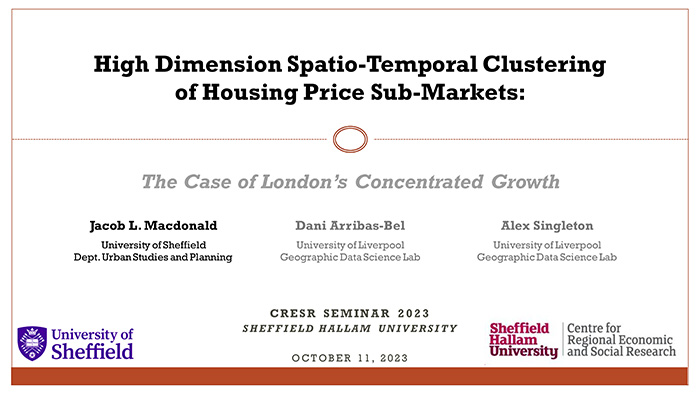Speakers
Jacob Macdonald, Lecturer in GIS and Spatial Analysis
Abstract
We look at the clustering of small-area geographies into distinctive housing price sub-markets according to their spatial and temporal dynamics. The monthly nature of transactions and clustering highlight high-frequency neighbourhood dynamics and trajectories within London. The classification of neighbourhoods is done on a spatio-temporal longitudinal database capturing high-resolution monthly price dynamics along with a series of generated spatial and temporal lags to characterise the persistence of local prices. We use estimated spatial and temporal machine learning features to characterise neighbourhood clusters, identifying three large collections of sub-market zones with positive price growths, and auxiliary clusters capturing declining neighbourhoods or those which are spatially isolated. The clusters each represent a different level of prices and growth ranging from ultra-high priced, moderately-high priced and the more ambient price class. For each of these broad groupings iterative sub-clustering identifies distinctive sub-groups with marginally different characteristics. The clustering output is able to identify those neighbourhoods in the urban area which deviate from the ambient class over time. Transition plot matrices are used to visualise longer term transitions. As neighbourhoods move into moderately or ultra-high priced zones, we can study the evolution of changing boundary extents. This is useful for highlighting both the rapid housing growth over time and the importance of locational granularity.
Biography
Jacob Macdonald is Lecturer in GIS and Spatial Analysis with the Dept. of Urban Studies and Planning. He completed his PhD in Economics and Finance at the Nova School of Business and Economics, and then worked as a Geographic Data Scientist with the University of Liverpool and the Geographic Data Science Lab/ Consumer Data Research Centre. His teaching and research combines applied data science, urban and environmental spatial analysis for policy and planning.

